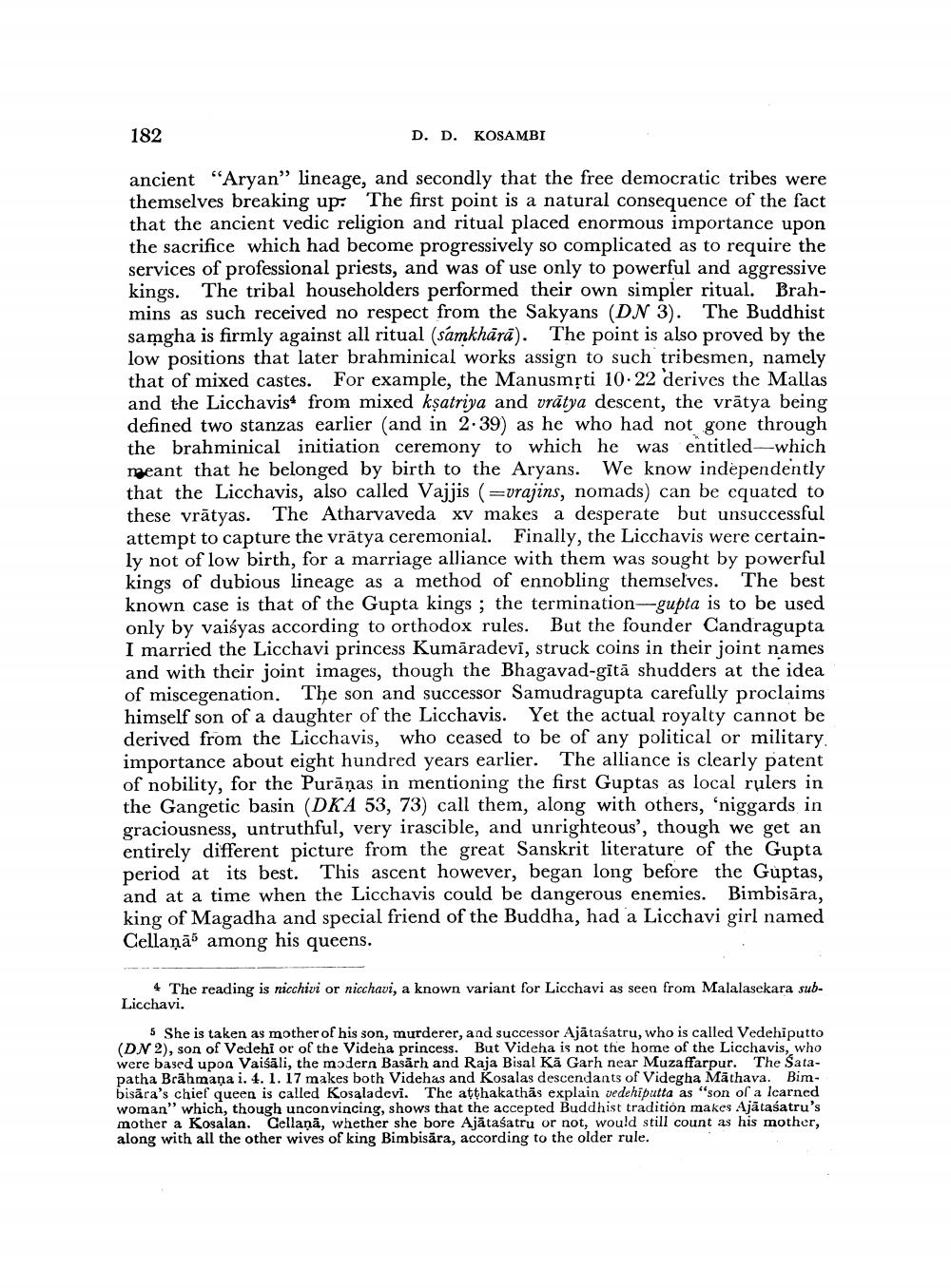Book Title: Ancient Kosala And Mmagadha Author(s): Dharmanand Kosambi Publisher: D D Kosambi View full book textPage 3
________________ 182 D. D. KOSAMBI ancient "Aryan" lineage, and secondly that the free democratic tribes were themselves breaking up: The first point is a natural consequence of the fact that the ancient vedic religion and ritual placed enormous importance upon the sacrifice which had become progressively so complicated as to require the services of professional priests, and was of use only to powerful and aggressive kings. The tribal householders performed their own simpler ritual. Brahmins as such received no respect from the Sakyans (DN 3). The Buddhist samgha is firmly against all ritual (samkhārā). The point is also proved by the low positions that later brahminical works assign to such tribesmen, namely that of mixed castes. For example, the Manusmộti 10.22 'derives the Mallas and the Licchavist from mixed kşatriya and vrátya descent, the vrätya being defined two stanzas earlier (and in 2-39) as he who had not gone through the brahminical initiation ceremony to which he was entitled—which meant that he belonged by birth to the Aryans. We know independently that the Licchavis, also called Vajjis (=vrajins, nomads) can be equated to these vrātyas. The Atharvaveda xv makes a desperate but unsuccessful attempt to capture the vrātya ceremonial. Finally, the Licchavis were certainly not of low birth, for a marriage alliance with them was sought by powerful kings of dubious lineage as a method of ennobling themselves. The best known case is that of the Gupta kings; the termination--gupta is to be used only by vaisyas according to orthodox rules. But the founder Candragupta I married the Licchavi princess Kumāradevī, struck coins in their joint names and with their joint images, though the Bhagavad-gītā shudders at the idea of miscegenation. The son and successor Samudragupta carefully proclaims himself son of a daughter of the Licchavis. Yet the actual royalty cannot be derived from the Licchavis, who ceased to be of any political or military. importance about eight hundred years earlier. The alliance is clearly patent of nobility, for the Purāṇas in mentioning the first Guptas as local rulers in the Gangetic basin (DKA 53, 73) call them, along with others, 'niggards in graciousness, untruthful, very irascible, and unrighteous', though we get an entirely different picture from the great Sanskrit literature of the Gupta period at its best. This ascent however, began long before the Guptas, and at a time when the Licchavis could be dangerous enemies. Bimbisāra, king of Magadha and special friend of the Buddha, had a Licchavi girl named Cellaņā among his queens. 4 The reading is nicchivi or nicchavi, a known variant for Licchavi as seen from Malalasekara subLicchavi. 5 She is taken as mother of his son, murderer, and successor Ajātaśatru, who is called Vedehiputto (DN 2), son of Vedehi or of the Videha princess. But Videha is not the home of the Licchavis, who were based upon Vaiśāli, the modern Basärh and Raja Bisal Kā Garh near Muzaffarpur. The Satapatha Brāhmaṇa i. 4. 1. 17 makes both Videhas and Kosalas descendants of Videgha Mathava. Bimbisāra's chief queen is called Kosaladevi. The atthakathās explain vedehiputta as "son of a learned woman" which, though unconvincing, shows that the accepted Buddhist tradition makes Ajātaśatru's mother a Kosalan. Cellaņā, whether she bore Ajātaśatru or not, would still count as his mother, along with all the other wives of king Bimbisära, according to the older rule.Page Navigation
1 2 3 4 5 6 7 8 9 10 11 12 13 14 15 16 17 18 19 20 21 22 23 24 25 26 27 28 29 30 31 32 ... 34
